Lower Back Pain Causes
a Focus on Musculoskeletal Causes and Solutions
The lower back pain causes examined here at Lower Back Pain Answers focus on the musculoskeletal system.
There are many resources where you can learn about pathological causes of pain and for those I recommend the National Institutes of Health or Cleveland Clinic.
But if you suspect your pain has a musculoskeletal component, or you have been unsuccessful in receiving a clear diagnosis, then you have a very good chance of finding what you're looking for here.
In cases where the diagnosis is inconclusive, it becomes much more likely that the problem has a musculoskeletal origin. For more on this, please see the home page where I go into some detail about this topic.
lower back pain causes index
Iliopsoas Syndrome
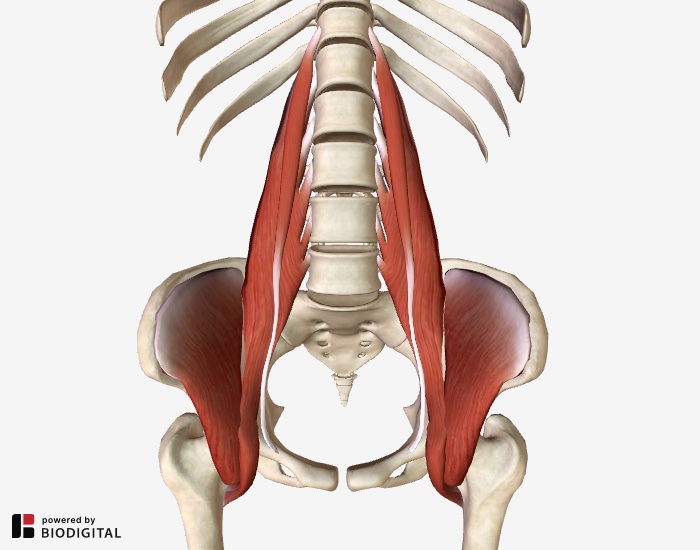 Iliopsoas muscle includes two muscles: the iliacus and the psoas.
Iliopsoas muscle includes two muscles: the iliacus and the psoas.When the iliopsoas muscle -- composed of the iliacus and psoas muscles -- becomes chronically tight and ischemic (low blood flow) from lack of exercise or too much exercise and inadequate stretching, myofascial trigger points can result causing pain and muscular recruitment (compensation).
The name that has been adopted to identify this collection effects is Iliopsoas Syndrome.
pelvic torsion
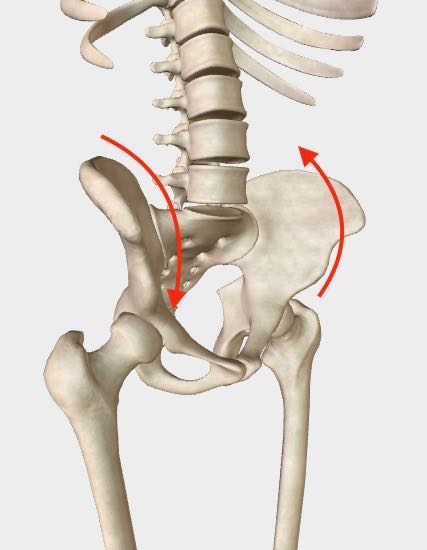 Right Anterior, Left Posterior Pelvic Torsion Pattern
Right Anterior, Left Posterior Pelvic Torsion PatternPelvic torsion is perhaps the most central of all lower back pain causes because of its impact on the entire structure of the body. Often referred to as a "twisted pelvis," pelvic torsion one of two primary postural distortion patterns. The other is, hyperflexion.
Pelvic torsion is extremely common and almost always results in a functional leg-length difference. It is this distortion that disrupts a benign relationship with gravity and turns it into a struggle. The result is a cascade of muscular compensations up the kinetic chain of the body leading to numerous problems.
tensor fascia lata dysfunction
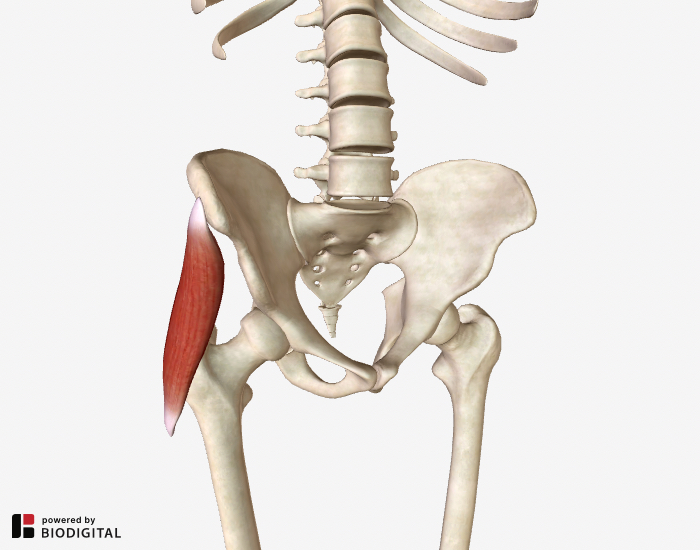 Right tensor fascia lata muscle
Right tensor fascia lata muscleTensor Fascia Lata Dysfunction is one of the most underappreciated lower back pain causes.
Not only can excessive tightness in this muscle be responsible for hip and groin pain, but also lower back pain as well.
sacroiliac joint dysfunction
Sacroiliac Joint Dysfunction occurs as a consequence of one of the sacroiliac joints, SI joints, becoming either hypo-mobile (meaning stuck or fixed) or hyper-mobile (meaning too loose or unstable).
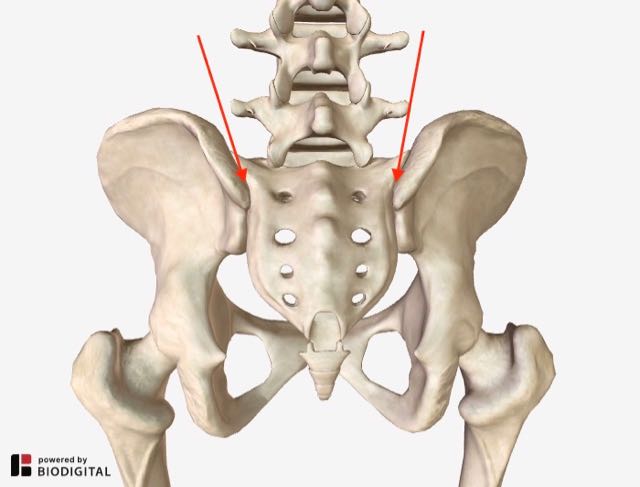 Posterior view of pelvis. Arrows indicate the two sacroiliac joints.
Posterior view of pelvis. Arrows indicate the two sacroiliac joints.Either of these states can result in pain or discomfort and both of these possibilities are referred to with the general designation of Sacroiliac Joint Dysfunction.
This dysfunction is one of one of the lower back pain causes that can produce symptoms that sometimes cause confusion with Sciatica.
Piriformis Syndrome
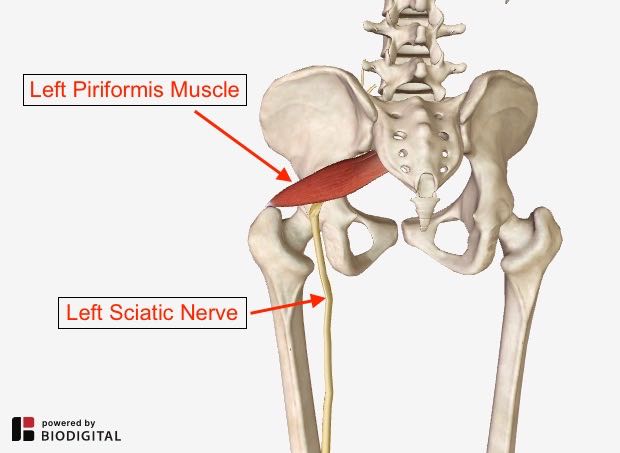 Left piriformis and left sciatic nerve.
Left piriformis and left sciatic nerve.Piriformis Syndrome is one of the more "popular" lower back pain causes but it is often misdiagnosed.
This syndrome is characterized by entrapment of the sciatic nerve by an extremely hypertonic piriformis muscle. Pain is often felt in the buttocks and sometimes down the back of the leg.
myofascial trigger points
Myofascial Trigger Points in ischemic muscles can refer pain to other parts of the body and is among the most ubiquitous of lower back pain causes.
Referred sensation could be pain, tingling, numbness, thermal sensations (hot/cold), or a generalized achey feeling.
SENSORY MOTOR AMNESIA
Sensory Motor Amnesia is one of the least known or least understood of all lower back pain causes.
It is a phenomenon whereby we lose sensory-motor control of our muscles allowing them to remain chronically contracted. Chronic muscular contraction is one of the chief causes of low back pain.
POSTURAL DISTORTION
If the body is not balanced and upright in gravity then muscular imbalance can develop causing postural distortion. Pelvic torsion, for example, is one form of postural distortion.
Such distortion can lead to muscular strain, ischemia, and myofascial trigger points.
TIGHT LEG MUSCLES
When the long muscles of the legs such as the hamstrings, adductors, and quadriceps are tight and short this can put tremendous strain on the lower back, especially when walking.
dysfunctional biomechanics
Any number of influences can result in dysfunctional body biomechanics and cause back pain including pelvic torsion, inflexible muscles, or faulty habitual movement patterns.
true Sciatica
When the sciatic nerve, the largest nerve in the body, becomes compressed by a bulging intervertebral disc, it can result in pain down the buttocks, the back of the leg, and sometimes foot.
True Sciatica must be distinguished from other causes which can produce sciatic symptoms such as myofascial trigger points and sacroiliac joint dysfunction.
herniated disc
When an intervertebral disc, which forms the cushion in between each of our vertebrae, becomes compressed, it can bulge to the point of bursting. This is a disc herniation.
lower back and hip pain
Often lower back and hip pain can present as a kind of moving target. Sometimes the pain is centered squarely on the outside of the hip joint near the hip bone.
Other times the pain can wrap around to the gluteal muscles. At times an individual might experience pain in more than one area.
The reason for this medley of possibilities is that muscular compensation is often at the heart of lower back and hip pain.
Further, muscular compensation is a continual process in which muscles are constantly adjusting, trying to figure out how to make do with the circumstances they're presented with such as postural distortion.
stress
There is a strong connection between stress and back pain. Stress can cause chronic muscular contraction, postural distortion, and general fatigue.
Often muscular contraction can persist in the body, even when sleeping, and even after stressful circumstances have passed.
Static stretching
Especially with very tight muscles, static stretching can promote more back strain than relief. This is major problem for individuals either trying out yoga for the first time or just pursuing static stretches too vigorously. They push themselves too hard and end up straining themselves.
nerve compression and entrapment
Nerve compression and entrapment are included in this list because they both can have postural distortion as their root cause.
Nerve compression refers to the pressure on nerve root, at the spinal level, of an intervertebral disc on a spinal nerve.
Nerve entrapment refers to the pressure on a peripheral nerve by soft tissue such as when the piriformis muscle entraps the sciatic nerve or the pectoralis minor entrap the brachial plexus.
Fascial restriction
Fascia, a type of connective tissue, is a dense form of soft tissue which covers and interpenetrates every muscle, bone, nerve, artery and vein as well as all of our internal organs including the heart, lungs, brain and spinal cord.
In a normal healthy state, fascia possesses a wavy and relaxed configuration. It has the ability to stretch and move without restriction.
However, when we experience physical trauma, scarring, or inflammation, or when the fascia is not regularly moved through a broad range of motion, it can lose its pliability. It can become tight, fixed and short, and thereby a source of tension and restriction for the rest of the body.
Anatomy Images Courtesy of BIODIGITAL

|
CURRENT COURSES POSTURAL BLUEPRINT FOR CORRECTING PELVIC TORSION: The Complete Guide To Restoring Pelvic Balance (2022) STRETCHING BLUEPRINT FOR PAIN RELIEF & BETTER FLEXIBILITY: The Complete Guide to Pain-Free Muscles Using Active Isolated Stretching (2020) HEALING THE HIDDEN ROOT OF PAIN: Self-Treatment for Iliopsoas Syndrome (2013) FREE MINI COURSE: Introduction to Active Isolated Stretching |

